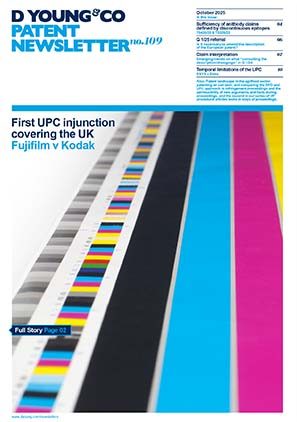Not an invention: excluded subject matter at the UKIPO
A patent may be granted for an invention which, among other requirements, is new and which involves an inventive step over the prior art.
However, not every development is actually considered to be an “invention”. Indeed, Section 1(2) of the UK Patents Act 1977 defines a non-exhaustive list of things which are not considered as inventions for the purposes of the UK Patents Act 1977 (known as excluded subject-matter areas). These include, among other things, a mathematical method, an aesthetic creation, a method of doing business, and a program for a computer. Similar exclusions apply also to European patent applications under Article 52(2) of the European Patent Convention (EPC). A patent will not be granted if the claimed invention falls solely within one or more of these excluded subject-matter areas.
A recent decision by the hearing officer to refuse patent application GB2213917.4 highlights the way in which excluded subject matter is applied at the UK Intellectual Property Office (UKIPO).
The invention
The invention in GB2213917.4 related to a method of converting a restricted payment account on a portable electronic device of a first user to a new primary account, where the restricted payment account is a sub-account of a primary account of a second user.
As an example, a child (a first user) may have a restricted payment account on a smartphone linked to a payment account of their parent (a second user). Then, when a certain threshold is met, such as the child reaching a certain age, the child may be presented with a conversion option to enable conversion of the restricted account to a new primary account. This effectively breaks the ties with the parent’s account such that the parent can no longer place restrictions on the child’s account. Furthermore, information such as transaction history is no longer shared between the child and parent. Accordingly, the applicant, Apple Inc, had argued, as described also in the application, that the invention improved security of establishing payment accounts and protected user privacy.
The law
In order to assess whether an invention falls within the excluded subject-matter areas defined by Section 1(2) of the UK Patents Act 1977 it is necessary to apply the relevant case law. In Aerotel v Telco ([2006] EWCA Civ 1371) the Court of Appeal set out the following test:
- Properly construe the claims.
- Identify the actual or alleged contribution.
- Ask whether it falls solely within the excluded subject matter.
- Check whether the actual or alleged contribution is actually technical in nature.
Applying step two of the Aerotel test, the hearing officer assessed the contribution of GB221917.4 to lie in the process of converting an existing restricted account to a new unrestricted account: using personal information stored by the electronic device when setting up the original restricted device.
The next step was then to consider whether this contribution falls solely within excluded subject matter: step 3 of the Aerotel test.
In order to make this assessment the hearing officer considered guidance from paragraph 35 of Halliburton Energy Services Inc’s applications [2012] RPC 12, which explained that implementing a business method on a computer does not itself make any technical contribution. While the conversion process takes place on an electronic device based on metadata stored on the device, this does not make the business method technical. Indeed, the hearing officer considered that improved security of establishing payment accounts and protected user privacy was achieved by an adaptation of a computer-implemented business method to avoid the sharing of personal data based on information already held within the electronic device.
On this basis, the hearing officer decided that the underlying problem of sharing personal data was circumvented through a non-technical modification of the authorisation requirements of a business process. In other words, the invention did not provide a technical solution to the underlying technical problem but rather circumvented the technical problem through changes to the business process. This was not sufficient to avoid the excluded subject-matter restrictions.
The application was refused under the excluded subject-matter restrictions as relating to a method for doing business and a program for a computer.
Conclusion
When drafting a patent application, care must be taken to describe the invention in a way which focuses on the patentable aspects of the invention and minimizes the risk of the application being refused for excluded subject matter.
Case details at a glance
Jurisdiction: United Kingdom
Decision level: UKIPO
Parties: Apple Inc
Citation: BL O/0010/24
Date: 08 January 2024
Useful links
- Aerotel Ltd v Telco Holdings Ltd & Ors, [2006] EWCA Civ 1371, England and Wales Court of Appeal, 27 October 2006: dycip.com/aerotel-telco-2006
- Halliburton Energy Services Inc [2012] RPC 12, England and Wales High Court, 05 October 2011: dycip.com/halliburton-energy

